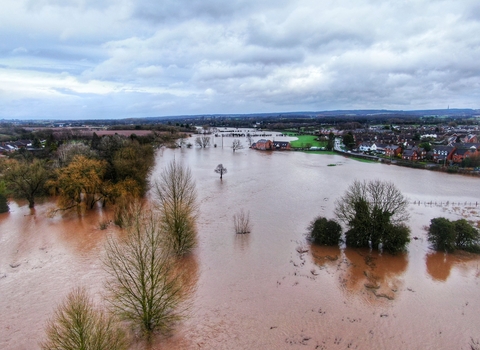What is Natural Flood Management
NFM is an affordable, sustainable method of flood management which uses natural processes to slow the flow of water through the landscape to reduce flood risk and erosion. These techniques are crucial in the fight against climate change.
NFM is a type of nature-based solutions which benefits both people and wildlife. Along with flood management, these types of solutions provide secondary benefits which include increasing wildlife in rivers and streams by restoring and creating habitats and improving water quality by enabling sediments which are often high in phosphates to drop out the water column.
Watch the video below to see what Natural Flood Management work we are doing in Staffordshire to help in the fight against climate change.
A natural solution to the climate crisis
When implemented a catchment scale, NFM measures act as a chain of sponges that take the peaks out of flash flood events, which are becoming increasingly common as part of our changing climate.
For example our Jacksons Coppice Nature Reserve acts as a flood storage area, holding back water high up in the River sow catchment which intern reduces flooding downstream at Eccleshall and Stafford. Both towns are vulnerable to flooding and were severely impacted during the October 2019 flood event. Storing and holding back more water higher in the River Sow catchment is expected to benefit both Eccleshall and Stafford by alleviating the worse effects of future flood events.

Threats and pressures
The main challenge for Natural Flood Management is finding suitable and decent sized landholdings to implement these measures as well as landowners who want to take part. The Trust have managed to target a variety of landholdings across a series of priority catchments in the county, such as the Upper Sow, to look for opportunities to store water and reduce run-off, working closely with landowners and farmers.
What does Natural Flood Management involve
NFM measures seek to protect, enhance, emulate or restore natural functions of a river, such
measures include:
- Reconnecting watercourses with their floodplain and creating storage areas such as attenuation ponds and swales which are vegetated drainage features that fill up with water during a flood event and empty slowly. These storage areas also act as sediment traps, detained water enables sediment to settle at the base of the excavated area and takes sediment high in nutrients out of the water column.
- Restoring bends and meandering modified rivers acts to slow the flow in-channel
- Installing leaky barriers within steams and rivers is another measure, leaky barriers are designed to hold back flood water in-channel and encourage water to spill onto the banks or a storage area reducing flooding downstream.
- Planting trees and hedgerows increased water absorption, reducing the volume of surface water entering a watercourse to essentially slow the flow;
- Working with farmers to encourage sustainable agricultural practices which improve soil structure and reduce soil compaction to increase infiltration rates; (machinery and livestock, increase surface water runoff rates, winter cover crops)
- Peatland restoration is also a form of Natural Flood Managment, the peats ability to hold water means that it acts as a natural buffer against flooding, slowing the flow of water through the uplands of a catchment and helping to reduce flood risk downstream.
Let nature help
Find out more about our the other Nature based solutions work the Trust are doing in Staffordshire and how it is helping to fight climate change

